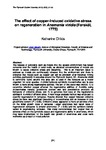The effect of copper-induced oxidative stress on regeneration in Anemonia viridis (Forskäl, 1775)
| dc.contributor.author | Childs, K. | |
| dc.date.accessioned | 2019-05-16T09:29:17Z | |
| dc.date.available | 2019-05-16T09:29:17Z | |
| dc.date.issued | 2013 | |
| dc.identifier.citation |
Childs, K. (2013) 'The effect of copper-induced oxidative stress on regeneration in Anemonia viridis (Forskäl, 1775)', The Plymouth Student Scientist, 6(2), p. 31-55. | en_US |
| dc.identifier.issn | 1754-2383 | |
| dc.identifier.uri | http://hdl.handle.net/10026.1/14034 | |
| dc.description.abstract |
The release of pollutants such as metals into the aquatic environment has raised concerns over the health of coral reefs, as elevated concentrations of metals are known to cause oxidative stress and bleaching. This is an important issue to address as metals are continuously released into the environment and there is evidence that metals such as copper can still be prevalent after historical mining activities, particularly in estuaries around the Plymouth Sound, UK. Anemonia viridis is commonly found around this area and is used in the literature as a model organism for coral species. A.viridis harbours symbiotic zooxanthellae and is also known to have strong regenerative abilities. The aim of this study was twofold: 1) to determine whether copper affected the regenerative abilities of A.viridis, using zooxanthellae density, glutathione content and lipid peroxidation products as indicators of oxidative stress, and 2) to generate new data on the regenerative abilities in A.viridis of different sizes. A new image analysis method was employed to quantify regeneration in tentacles. Results showed that copper induced oxidative stress as there was significant bleaching of zooxanthellae and an increase in total glutathione content (P < 0.05). Oxidative stress appeared to have an adverse effect on the initial growth rates of tentacles. Larger anemones had faster rates of regeneration compared to smaller anemones (P < 0.05) and the symbiont density varied in regenerating tentacles. This study demonstrated that copper had an adverse effect on the symbiotic status and regenerative ability in anemones, which may have implications for the health and growth of anemones and coral reefs worldwide as a result of metal pollution. | en_US |
| dc.language.iso | en | en_US |
| dc.publisher | University of Plymouth | |
| dc.rights | Attribution 3.0 United States | * |
| dc.rights.uri | http://creativecommons.org/licenses/by/3.0/us/ | * |
| dc.subject | pollutants | en_US |
| dc.subject | aquatic environment | en_US |
| dc.subject | coral reefs | en_US |
| dc.subject | mining activities | en_US |
| dc.subject | A.viridis | en_US |
| dc.subject | zooxanthellae density | en_US |
| dc.subject | Plymouth Sound | en_US |
| dc.subject | metals | en_US |
| dc.title | The effect of copper-induced oxidative stress on regeneration in Anemonia viridis (Forskäl, 1775) | en_US |
| dc.type | Article | |
| plymouth.issue | 2 | |
| plymouth.volume | 6 | |
| plymouth.journal | The Plymouth Student Scientist |



